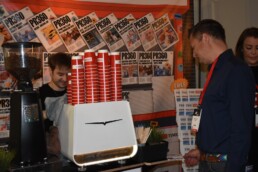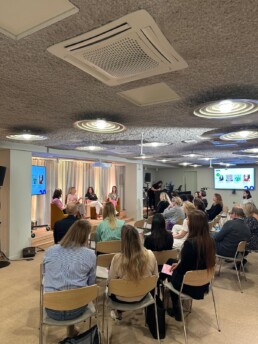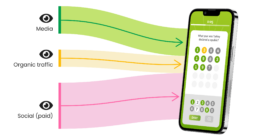Insights From PR360
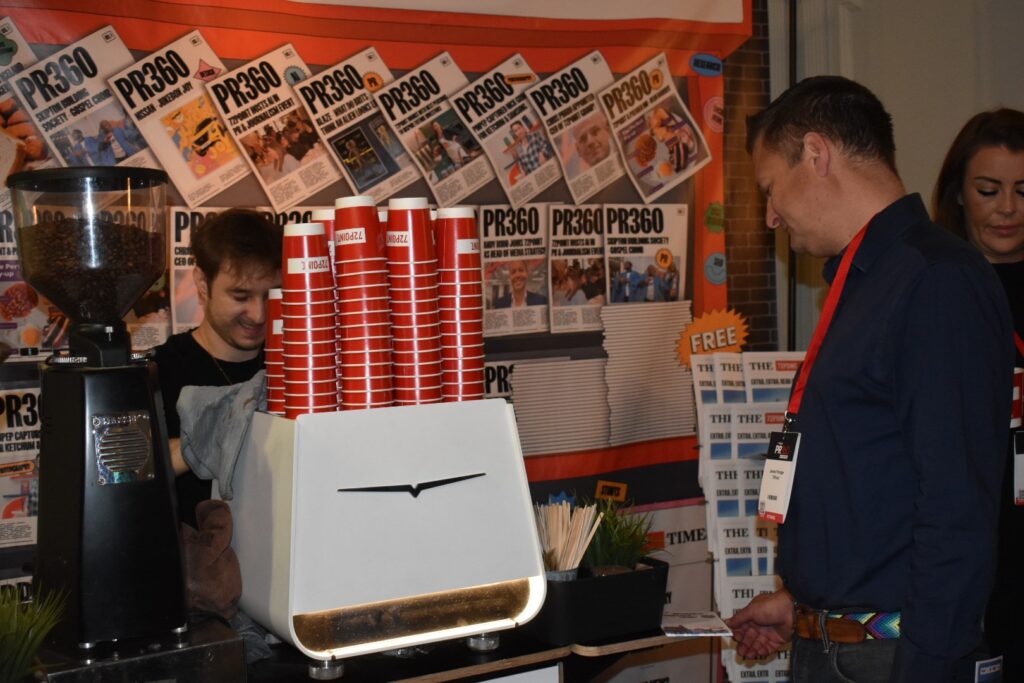
Returning to the office (well home office at least) after spending the last two days in Brighton at PR Week’s PR 360 Event – I thought I would share some reflections from the event and what the key players in the world of PR were talking about.
As the industry navigates its way through some pretty choppy waters in terms of the economic climate – taking inflation into account the entire industry was flat year on year for the first time in many years - technological advancements (AI) and shifting media landscapes are forcing PR practitioners to re-evalutate PR’s role in the marketing mix.
I think there were four key topics that came up in discussions – time and again –
Changes to traditional mainstream media - fewer journalists with less time on their hands is changing the dynamic between the PR industry and the media.
The changing role of influencers (or “earnfluencers” hat tip to our friends at Porter Novelli for that one) in PR – and their increasing importance in a social first world.
The threats and opportunities of AI – will AI sound the death knell for the PR industry or be a catalyst for a new era of PR?
The importance of creativity – Some fascinating insights from both brands and agencies on how they seek to maximise creativity in PR.
The Changing Media Landscape: Navigating Through the Digital-first Terrain
The significant reduction in journalist numbers in mainstream media, the move to digital first publishing and the continued rise of social media revolutionizes the media landscape, blurring the lines between traditional and new media channels.
Getting through to journalists is now tougher than ever. It's crucial to have strong relationships with the media and a clear understanding of the current needs of jounalists in this changing environment – traditional approaches are no longer working.
In this new world, the PR industry is having to re-imagine their approach to media, whilst continuing to craft compelling narratives that resonate across diverse media platforms.
The continued democratisation of content creation is empowering individuals and influencers to wield significant influence, challenging traditional gatekeepers and reshaping brand-consumer dynamics.
But there was a sense that PR is re-evaluating the role of influencers and there was a feeling that a more nuanced approach is required – rather than just chasing large but potentially irrelevant influencers with large followings – a more strategic and targeted approach was required.
There was also a sense that the audience for this social content is becoming more aware and averse to being force-fed commercial content.
The Role of AI in PR and Media: Balancing Threats and Opportunities
I don’t think there was one session where Artificial Intelligence (AI) was not discussed - AI emerges as a double-edged sword in the world of PR. On one front, AI-powered tools can help to streamline processes, automate mundane tasks, and augment data analysis, even help with creativity - empowering PRs to delve deeper into audience insights and craft targeted strategies.
However, the spectre of job displacement looms large, as AI threatens to automate routine tasks, compelling professionals to upskill and adapt to remain relevant in an increasingly AI-driven landscape.
-
PR Reinvented: Creativity as the Catalyst for Innovation
Amidst this evolving landscape, there were some strong voices calling upon the industry to re-establish itself as a cornerstone of the marketing mix, transcending its traditional role and embracing creativity as the catalyst for innovation. I really enjoyed a fascinating presentation by Caroline Fisher, Communications Director at ASICS on the importance of finding new creative ways to tell the same story – talking about the power of great storytelling, to captivate audiences and forge emotional connections that endure beyond fleeting impressions – and importantly drive sales and affect purchasing decisions.
Embracing the Future: Navigating Uncertainty with Agility and Adaptability
As the UK PR industry traverses uncharted territories, practitioners are confronted by a landscape fraught with uncertainty and disruption. Yet, amidst the challenges lie unprecedented opportunities for innovation, growth, and reinvention. By embracing AI as an enabler of creativity, harnessing the transformative power of influencers, and championing a culture of innovation, the UK PR industry can chart a course toward a future where storytelling reigns supreme, relationships are paramount, and creativity knows no bounds.
It feels like now is the time to re-imagine PR.
Navigating the PR Industry as a Mum to a Child with SEND: Insights and Strategies
Being a mum is a full-time job in itself, but when you add navigating the demanding landscape of the PR industry while also caring for a child with special needs and disabilities (SEND), the challenges can seem overwhelming. Today, we hosted discussions with PR Mums, FORA, and CIPR GLG to shed light on some invaluable insights and strategies for thriving in both roles.
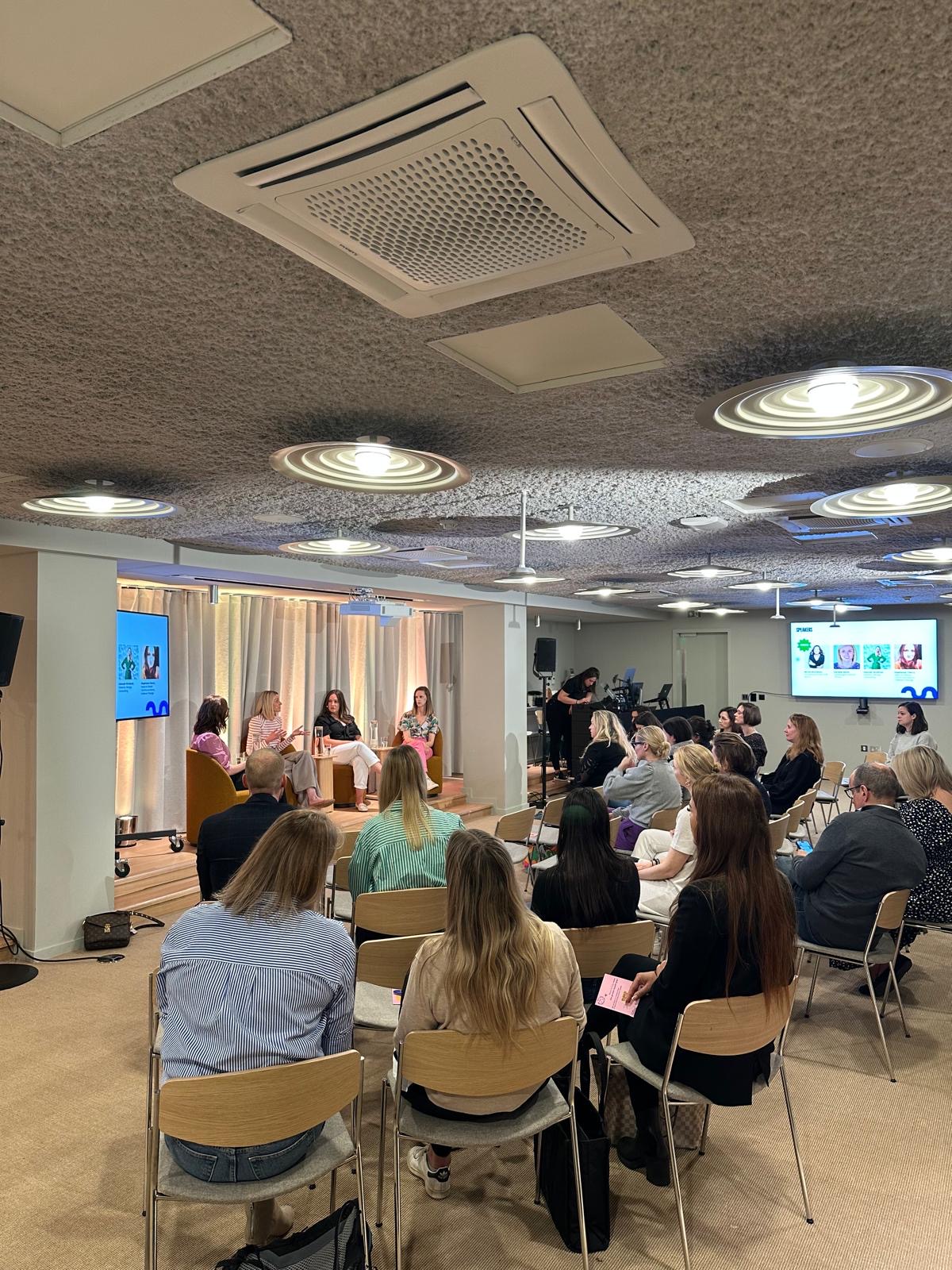
Huge thanks to our speakers:
- Nicola McKelvey, Founding Mother of PR Mums
- Danielle Baird, Campaigns Director, 72Point
- Stephanie Cherry - Head of Global Communications, Unilever Prestige
- Hannah Wrathall, Director, Wrapp Consulting
Who took time to share their personal experience as Mothers with children with special needs. Top take from the panel discussion aways included:
Open Communication is Key
One resounding piece of advice echoed throughout our discussion was the importance of open and transparent communication. Whether it's with your People & Culture team or your line manager, speaking up about your situation, even before diagnosis, can pave the way for understanding and support.
Finding Support in Unexpected Places
For mums with children still in mainstream schools, do ask other parents for support. Explain your situation in the school WhatsApp group. Your mum's group can be an invaluable resource, providing empathy, understanding, and practical advice that only those in similar situations can offer. And you’ll be surprised at how flexible other parents and children will be in joining inclusive activities with your child.
Employer Transparency and Support
Employers at PR agencies and brands alike play a crucial role in creating a supportive environment for mums of children with SEND. Transparency about policies and available support can alleviate some of the stress and uncertainty that comes with balancing work and caregiving responsibilities.
Balancing Career and Caregiving
Knowing when to lean into your career and when to prioritize your caregiving duties is a skill that many PR mums have honed. It's important not to put undue pressure on yourself to excel in both areas simultaneously. Finding a balance that works for you and your family is key to long-term success and happiness. Do have open discussions with your employers and clients and don’t be afraid to request to switch to less pressured accounts if you are working in an agency.
Patience and Long-Term Thinking
Employers should have patience and take a long-term view when it comes to their staff who are mums of children with SEND. Loyalty and dedication often pay off in the form of highly efficient and committed workers who bring unique perspectives and skills to the table.
Multitasking Superpowers
Mums of children with SEND possess multitasking abilities that are second to none. Their capacity to juggle multiple responsibilities with grace and efficiency makes them valuable assets in the workplace.
Harnessing Industry Power
Finally, it's crucial to recognise the power within the PR industry to shape perceptions and generate awareness about the challenges faced by mums of children with SEND. By advocating for inclusivity and understanding, we can create a more supportive and inclusive environment for all.
How quizzes can provide meaningful metrics for PR
Quizzes are a powerful tool for marketing campaigns as they can educate, engage and create a connection with your audience while giving meaningful insight and data for marketers. Adding quizzes and interactives to your campaign can be the difference between your creative idea really driving compelling results, and it falling flat. At 72Point, we’ve noticed a 60% increase in our clients opting for quizzes over the last year, and here’s why…
The interactive nature of a quiz allows participants to test themselves on a topic and learn new insights in a fun and engaging manner. Unlike other forms of content such as reading or watching videos, quizzes provide instant feedback and require active participation, creating a uniquely engaging experience that keeps them mentally involved in the content. Gamification elements can also be incorporated for a sense of achievement such as leaderboards or user scores, both of which can encourage social interaction via sharing of their results or challenging other players.
In addition to being engaging, quizzes also offer valuable insights to marketers and brands through either anonymous data tracking such as utilising Google Tags to understand actions being taken, or voluntary data collection such as email capture to view quiz results.
We believe that 4 key components should be considered when building an effective quiz: awareness, engagement, a strong Call to Action (CTA) and effective data tracking.
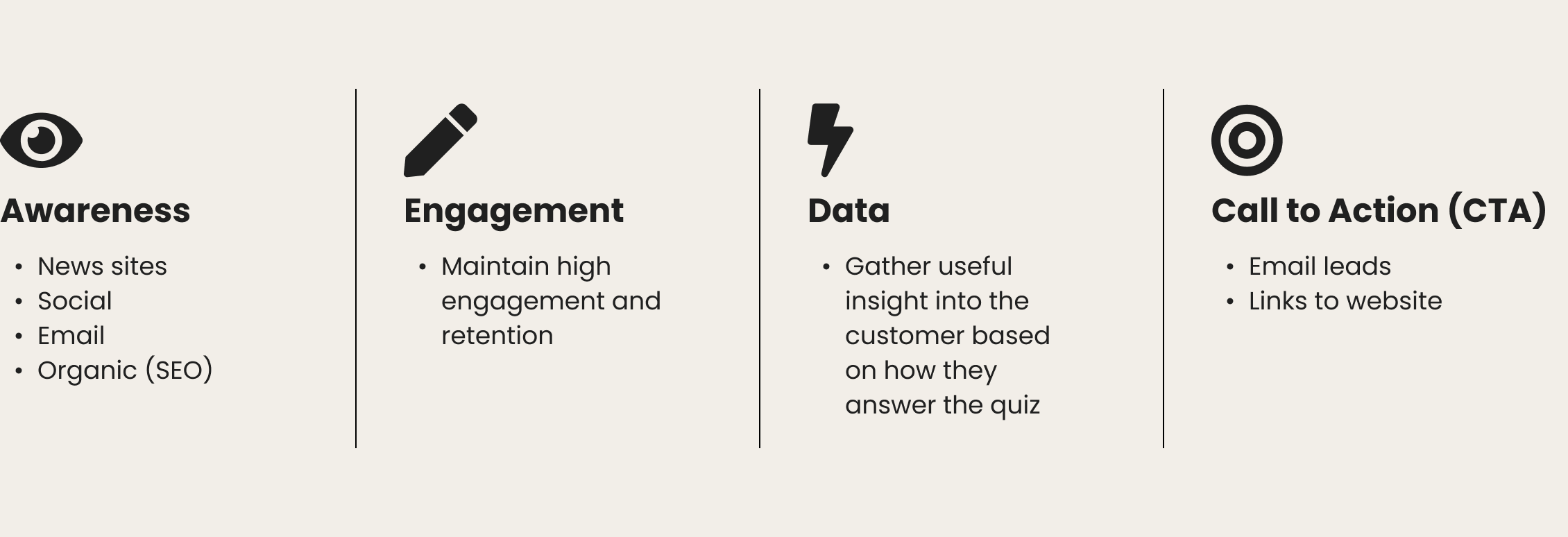
From our experience of creating quizzes for nearly 100 different brands including Ordnance Survey, Oddbox, Plum & Readly these are our top tips on maximising the results of your next quiz.
Awareness
Once a quiz has been created awareness needs to be generated to drive traffic and users to take the quiz. There are multiple channels in which a quiz can be shared such as media outreach, social, organic and email marketing.
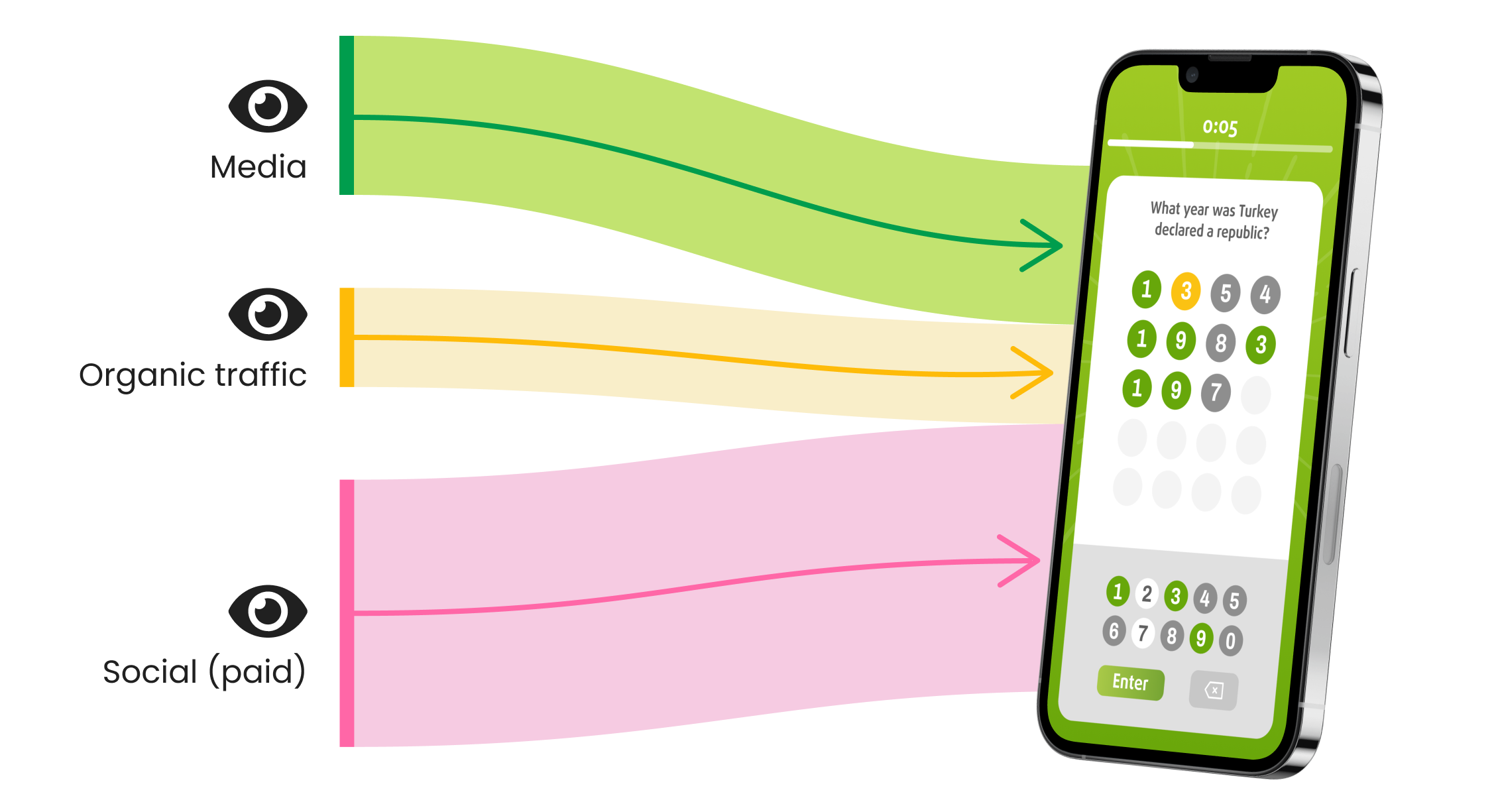
At 72Point we can gain awareness of a quiz through a news release. The quiz can either be embedded within the news article or hosted on the clients website and linked to within the copy, this approach can also have SEO benefits. Social is another highly effective route to gain awareness either through organic or paid campaigns. Sharing the quiz on social allows you to better target your audience, and reach users who are more likely to be interested in the quiz topic.
Through an effective paid social ad campaign and news generation activity, our client Osome was able to achieve 10,000 quiz views, 7600 quiz completions and 2,000 CRM leads.
“For our Side Hustle Test they helped create an engaging and shareable campaign which drove 10,000s hits to our website. It was terrific and we’re still dining out on it to this day.”
Paul Afshar, Marketing Director, Osome
Engagement
Once you have successfully generated enough awareness of the quiz amongst your target audience, the next step is to ensure a high level of participation and engagement.
We can measure the engagement of a quiz in several ways including time spent completing the quiz (dwell time) as well as monitoring at which point users drop off. Using this insight the quiz can be optimised. From our experience a quiz of around 6-10 questions performs best as people don’t lose interest and abandon the quiz while providing sufficient engagement for the quiz to be rewarding to complete. This of course depends on the topic of the quiz and how targeted it is to an audience, however for broad appeal this is a good guide to stick to.
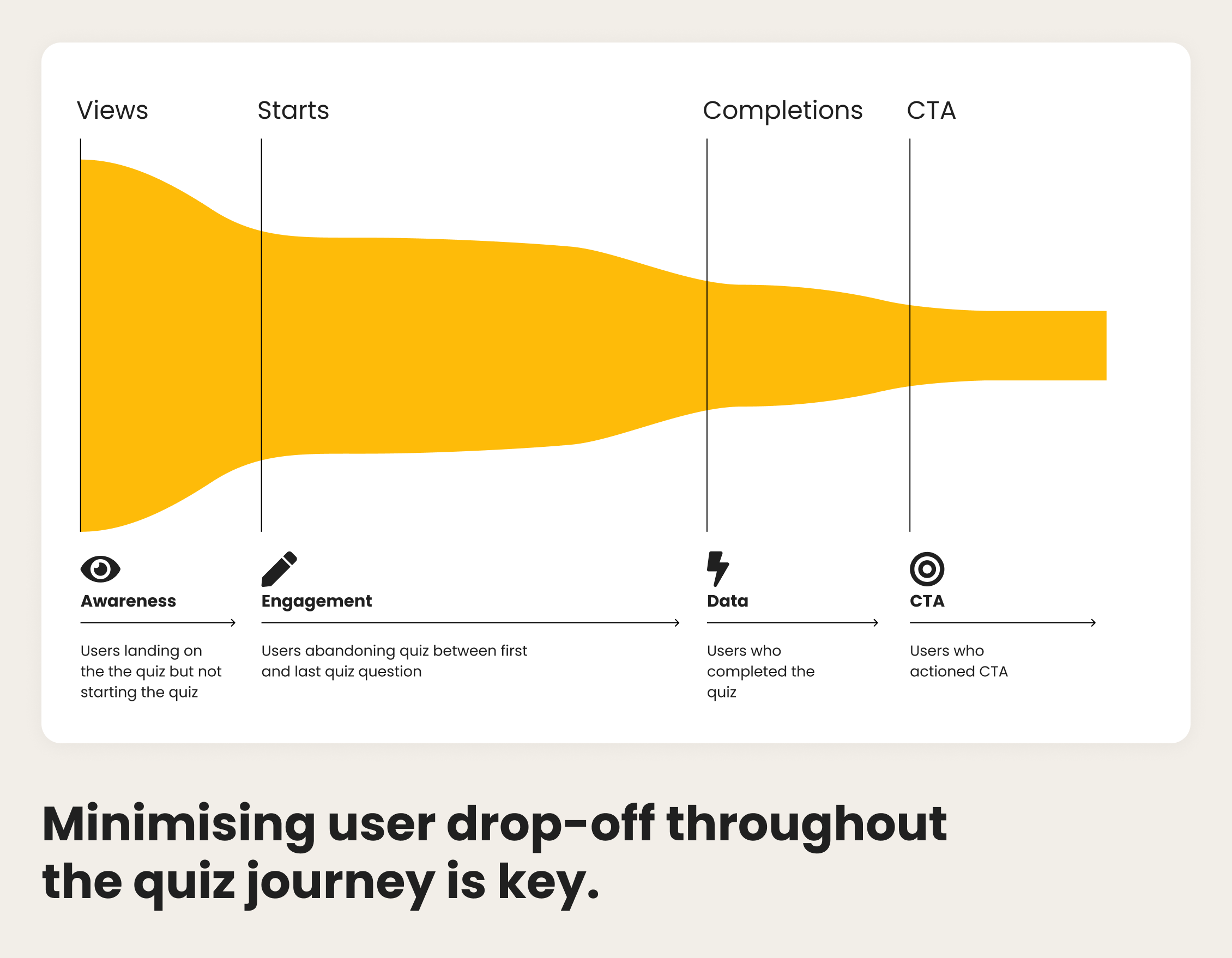
Over the last 6 months our quizzes have had an average of 5.6k completions and a dwell time of 2m38s with over half (55%) completing the full quiz. That’s roughly 246 hours of user engagement per quiz.
Visuals such as illustrations, animated GIFs or video can add additional interest and make the quiz more engaging. Keeping questions and answers concise also improves completion rates and retention.
Data
One of the advantages of creating a quiz is the whole wealth of data available which can add meaningful insight to PR campaign reporting. Examples of data available are views, completions, dwell time, answers for specific questions, average scores and more.
Anonymous data can be used to inform additional activity or insight into topics that require further education such as learning what questions in the quiz were most incorrectly answered.
Voluntary data collection or ‘first party data’ is highly valuable data collected directly from your audience. Within a quiz this could be gathered via a form prior to viewing quiz results. This is likely to impact overall quiz completion rates so it is worth considering the main objectives for the quiz.
Data such as knowing the participants quiz score or outcome can be utilised in tailored marketing responses to build stronger, relevant customer relationships.
Call to Action
At the end of a quiz there should be a clear CTA. Depending on your goals it can vary to include email signups, links to webpages or social sharing.
For a lead generation quiz the CTA would encourage participants to provide their email and other data. An educational quiz may provide additional information via a ‘learn more’ button. A quiz used to identify the best product suited to the user may include links to purchase. Regardless of the CTA, it is important that it is relevant and provides value to the user.
For Mr. Fothergill’s we created a “What type of gardener are you?” quiz which asked for participants email address data in return for their quiz results and the incentive of free seeds. The quiz achieved an incredible 4,000 email leads for the client.
Summary
In summary, quizzes are a highly effective tool for creating brand awareness, while their interactivity and instant feedback invites engagement and can offer a personalised experience. At 72Point, we specialise in deploying a variety of tactics, including news and social distribution, to maximise the impact of our quizzes and content. The amount of data collected from our activity means we have a vast amount of insight on what works, and what doesn’t and means we are well placed to work with clients, consider all of the above, and create standout campaigns.
For more information on our content marketing services, request a ratecard below:
Vacancy: Senior Creative Account Manager - Maternity cover
Employer: 72Point Ltd
Title: Senior Creative Account Manager
Employment type: Full time maternity cover
Start date: January/February 2023
Location: Bristol
Who we are:
72Point is the market-leader in content creation.
We generate, produce and deliver top quality news stories, pictures, videos, visual puzzles and animated infographics to the national news media and beyond.
Our client list includes a string of huge global brands, as well as some of the biggest names on PR Week’s Top 150.
We land coverage every day in print, online and via social platforms.
We are part of the SWNS Media group. SWNS proudly brings the heartbeat of Britain to life for our biggest news brands. Every day, hundreds of our stories, images and videos are published and broadcast across the national media.
SWNS content spans breaking news, court cases, amazing human interest stories, consumer issues, health studies, scientific breakthroughs, opinion polls, and stunning imagery and viral videos.
We distribute to the biggest news publishers in the world – from the Sun, Mirror and Daily Mail to the Times, Telegraph and New York Post.
Who we’re looking for:
We're after a senior creative account manager to join our team in Bristol as maternity leave cover – who will have at least 3 years’ experience working in a PR agency.
You will be ambitious, super-keen and a fast learner, and able to hit the ground running.
You must have a keen interest in popular news content across digital, social and print platforms, a fascination with how the industry works and a hunger to soak it up.
A minimum of an A Level in English and / or Media Studies is desirable.
You must also be calm under the pressure of tight deadlines, brilliant at juggling multiple pieces of work, and be able to build a rapport with our clients with your friendly and warm telephone and email communications.
The role:
Based at our Bristol HQ, the role will involve overseeing projects for clients from the idea stage to the subsequent issue to the national news media.
The successful candidate will generate strong creative concepts, contribute to brainstorms, pitch to clients, write up ideas, compile survey questions, write tight, engaging news copy and attend meetings / calls regularly.
They will also liaise with the digital, video, design and social teams to ensure projects run seamlessly.
This role will give you a unique understanding of all parts of our business and the wider news and PR industry.
The successful candidate will have the flexibility of working from home once a period of training has been concluded. However, all staff are currently required to work from the office for a minimum of two days per week.
All applicants will ideally have:
3 years working in a PR agency
A qualification in English A Level / be able to demonstrate excellent written skills
Be confident and personable with the ability to quickly strike a rapport with people, both in person and on the phone
Have an understanding of, and interest in, how news stories are presented in the digital environment
Benefits:
SWNS has a generous and growing list of employee benefits, including:
- 25 days annual holiday plus eight Bank Holidays
- Company pension scheme with employer contribution
- Hybrid working policy
- Enhanced maternity and paternity packages
- Life assurance scheme
- Shopping discount scheme, tech benefit scheme
- Gym membership discount, Cycle to Work
- Savings on childcare
Please apply to adminnewsgen@72point.com with a CV and cover letter.
Why your email media pitches are ignored - Chris Pharo tells all to PRmoment
"I'm constantly asked to explain how creating content for wire distribution is different to crafting press releases, and what we mean by page-ready content."
Read Chris Pharo's piece on PRmoment here.
Sunday for Monday - Jay Williams tells PRCA why they are a win for clients
"Why do so many PRs rule out ‘Sunday for Mondays’? We routinely get pushback from clients when the slot is suggested. I don’t understand it. It seems that it has somehow become ‘received wisdom’ – perhaps on the basis of a project that failed to launch. But rejecting it out of hand is actually evidence of the disconnect between PR and the media. A misunderstanding of what the media wants".
Read more about how Sunday for Mondays are a win for clients here.
Creative Hits & Misses
Sam Brown, our very own Creative Director gives PRWeek her line up of creative hits and misses from over the past week, which saw the likes of Deliveroo and Ikea pioneering the eater weekend coverage.
Our Diary Is Filling Up...
There has been a notable increase in our clients requesting news generation support in recent weeks, cementing the importance of brands staying at the front of consumers mind now more so than ever. Clever content has always played an important role in marketing strategies, but in times of uncertainty, we place ever increasing value in the publications we trust.
People have more time on their hands and are constantly checking in with their favoured publications for engaging content that provides some light relief. Publishers are also actively seeking stories that engage, and there is plenty of appetite for PR activation.
That’s where we come in.
Our calendar is filling up, and the response we've been getting shows that demand is strong. Unique opportunities present themselves daily for brands to reach their consumers in powerful and meaningful ways.
We landed 2,590 pieces of coverage over 45 projects in March alone, and that count has already increased to 55 projects for April. We are specialists in landing stories on their desired platforms and liaising with clients on the expert messaging these stories contain.
Contact us now to talk about your news generation project, support on distributions/sell-in and widespread media coverage.
Influencer Marketing: What's It All About?

Celebrity endorsements have always been used to create excitement around a brand. But the prevalence of social media has welcomed a world of bloggers, content creators and influencers. Brands are noticing this, and now these people are taking over our timelines with #ads and are, in their own way, a whole new type of celebrity.
Influencer marketing involves businesses collaborating with popular, relevant influencers and micro-influencers within their niche to propel their brand’s message. By forming a partnership, the influencer will agree to share the brand through a strategy of reviews, social posts, promotional discount codes, and gifted products, usually on their social media channels.
Unlike celebrity endorsements, influencer marketing does more than just attach the face of a celebrity to a product. Although the strategies tend to overlap, a distinguishing factor separating celebrity endorsements and influencer marketing is that influencers are often real-life consumers themselves, with their passion for certain topics empowering them to influence the decisions of their followers. For example, the perfectly-sculpted fitness blogger who regularly posts their training regime is likely to be asked to advertise for a sportswear brand. The influencer’s followers will trust their recommendation and will probably use their unique promotional code to get discount when they buy the advertised product.
To keep in-line with the brand’s message and build an audience of trusting consumers, it is important to work with a suitable influencer - it wouldn’t make much sense for a food blogger to promote a new make-up product.
Think about Justin Bieber and the #MyCalvins campaign (sorry to bring my celebrity crush into this). Bieber isn’t an underwear expert and doesn’t need to be an underwear expert to recommend Calvin Klein, his fame is enough to drive an interest in the product.
Influencers, however, will often have an area that they specialise in, meaning their followers and themselves share a common interest, so when they endorse or recommend a product their followers are likely to take interest. To keep in-line with the brand’s message and build an audience of trusting consumers, it is important to work with a suitable influencer - it wouldn’t make much sense for a food blogger to promote a new make-up product if they want to appear authentic.
These social media celebs, who could range from a following from just a few thousand, up to several million, are highly regarded by their followers and share a strong rapport and relationship with them. By leveraging the voice of an influencer, a brand can build trust with their target audience by using the influencer to become part of an ongoing conversation across their social channels. With many influencers being bloggers, Youtubers, and models, this means a brand can constantly be provided with new posts, videos, edits and engaging and creative visuals. Influencers are constantly active, and constantly promoting themselves and the brands they partner with, and that’s the great power of social media – it is always ‘on’.
Brands should be using influencer marketing; it has proven to be a positive strategy to create noise and stand out among other businesses online. It is important in this world to have a presence on social media to not get left behind. These influencers can help to build large and engaged followings by driving traffic to social accounts, resulting in more potential consumers. We shouldn’t overlook the power of the Insta-famous!
Just Give Me The Recipe
By Jack Peat

Why is it so darn hard to find a recipe without the incessant guff these days?
Earlier this month Kathryn Watson, a reporter for CBS News, posted a concern that will have likely irked anyone who has ever used Google to search for the perfect meal.
“I hate recipes on the Internet”, she said. “I do not care about your cute little story and pictures. Just tell me the ingredients and how I’m supposed to turn them into deliciousness.”
We feel her pain, right?
Ever since foodie bloggers and gastro mags exploded on the internet we have been bombarded with alluring meal ideas which require you to navigate a barrage of nonsensical info before you get to anything remotely useful.
As actor Mickey White said in response to Watson’s grumble, “my favourite link on all Foodie blogs is “Jump To The Recipe””, which is surely one of the most utilised shortcuts on the internet right now.
Content-heavy approach
But the bloggers are not to blame for the infuriating scroll-frenzy that has become the scourge of most recipe searches; Google is.
A simple look through the recommended properties on its developer page will tell you all you need to know.
Some 20 elements should be incorporated in any recipe page to make it rank highly in search, many of which require a fully fleshed-out piece of writing to incorporate, which is why most foodie sites are adopting a content-heavy approach.
Structured data for rich results
It’s something that is worth bearing in mind for any site that could benefit from structured data as a means of enhancing its search visibility.
Structured data is increasingly being used by Google to display rich results and better understand the web page itself.
It’s the reason recipe results display with a rating, calorie count, cooking time and a text snippet in search, and you can build that out across several disciplines if you adhere to Google’s guidelines.
SEO experts
Here at 72Point, we are experts at creating SEO-optimised packages to enhance your search rankings using the power of the press.
Check out some of our useful resources below to find out how:
The Perfect PR Package For SEO
In An Age Where SEO Is King, This Project Ruled
Looking To Secure A Follow Link In Press Coverage? Follow Our Traffic Light System

